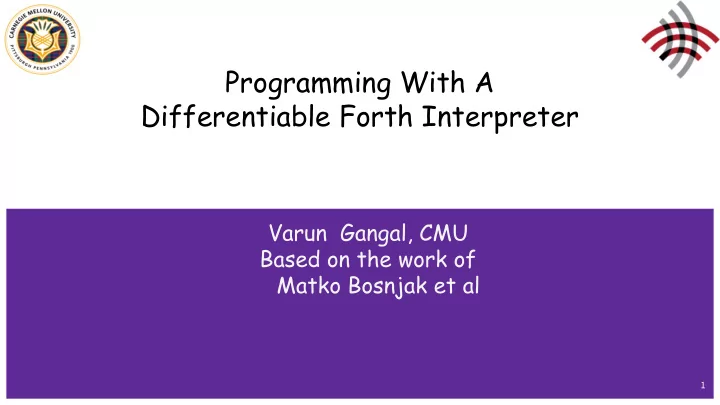

Programming With A Differentiable Forth Interpreter Varun Gangal, CMU Based on the work of Matko Bosnjak et al 1
What’s Forth? ● Kind of like a cross between Python and Assembly ● High-level imperative programming language BUT ● Can manipulate registers , stack exposed , load-stores ● It’s nice! because it is close to natural language (even Python is), but without assuming many layers of abstraction or compiling below (exposes stack etc) ● It’s dangerous ! No type-checking, no scope, no data-code separation, no mem.management 2
Reverse Polish Notation ● Postfix as opposed to infix notation ● Simple notion of precedence , no lookahead ● 3 4 + ; not 3+4; 234*+ not 2+3*4 ● No arguments or return values, no stack management ● One stack for all functions to operate on. ● Stack operations: SWAP, DROP, DUP ● Advantages: Super-fast execution, compilation 3
Example Code in Forth ● Literals pushed to DSTACK ● Call SORT, PC pushed to RSTACK ● TOS = Top of Stack, NOS = End of Stack ● 1- deducts TOS by 1. DUP duplicates TOS etc etc 4
Quotable Quotes ● “If C gives you enough rope to hang yourself with, FORTH is a flamethrower crawling with cobras” 5
Program State in Forth 1. DStack D : All operations, 2. RStack R : Return address, Buffer stack 3. Heap H 4. Program counter c: Next statement to be executed 6
7
Partial Procedural Knowledge ● How to visit a sequence ● How to traverse a tree ● Sketch : An incompletely specified code fragment. ● Provide a procedural prior ● Recollect rule templates from last time - kind of like that 8
What our model includes 1. Does the job of the compiler ( maintain and update program state ) 2. Takes in inputs (also inits program state with them) 3. Takes in partially specified programs a.k.a sketches 4. Learns learnable part of the programs 5. Trained on input-output pairs 6. Point 1 grants us end-to-end differentiability 7. It also makes our reads, writes, PC soft (uncertain) 9
What are we trying to do here? ● Program statement = Transition function f: S -> S ● Program = Transition Composition ● Output = Program(Input) -> Program encodes prior ● Sketches (more in detail later) : Incompletely specified statements/functions - sort of like rule templates from the logic stuff last time ● In this paper, all the transition functions are differentiable. The NN model is the compiler. 10
Let’s kind of walkthrough a Forth program - Bubble Sort 11
Just focus on the green lines for now! - Other 2 are sketches 12
Before the function call; Loop 13
Inside the Bubble Routine 14
Primitives - read, write, shift-increment, shift-decrement 15
Composites -push, pop 16
Composites - OVER, DUP, SWAP, IF.. ELSE 17
Sketches - Partial transition funcs, enc and dec specified 18
Execution - use program counter as attention vector 19
Traces - Discrete Init, later everything’s soft 20
Optimizations - For shorter gradient paths, faster training When no entry-exit, get composite transition function (symbolically) ● 21
Training 1. Training is based based on final stack state and stack pointer. 2. Includes a mask (to consider only elements <stack depth). 22
Sorting 23
Word Problems Dataset - Examples ● Roy & Roth ‘15. CC. 4 basic operators, upto 3 operands ● Prior approaches map to expressions e.g (50-15)+21 ● This one solves directly ● About 150 each for train, dev, test 24
Encoding the question ● BiLSTM to encode the question ● What’s used: States corresponding to numbers, and the final state, also numbers themselves 25
Key part of Word Problem Sketch 26
Results - Beats S2S Baseline 27
Sketch-based Models generalize well across lengths - Sorting 28
Sketch-based Models generalize well across lengths - Adding 29
Do the optimizations help? 30
How the PC was trained 31
32
Recommend
More recommend